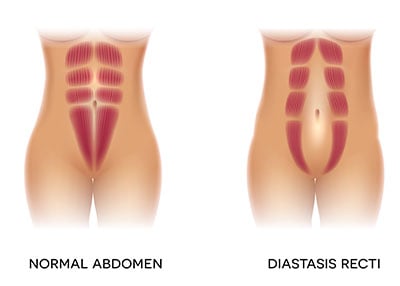Diastasis Recti – What You Need to Know

Many women experience something called Diastasis Recti following pregnancy. This is because a woman’s uterus is stretching to accommodate a baby, which causes the muscles of the abdomen to separate. This condition is treated by our surgeons at the Plastic Surgery Center, including Dr. Tushar Patel. Dr. Patel explains some commonly asked questions about the condition and treatment in the below Q&A.
Q: What is Diastasis Recti?
A: Diastasis Recti, in its simplest terms, is the separation of the rectus abdominal muscles in the vertical midline. What that means is that the “six-pack muscles,” called the rectus abdominis muscle, separate from from the midline creating a laxity or looseness in the core central mid-abdominal region.
Q: What are symptoms of this condition?
A: Patients can experience mild or no symptoms to very severe symptoms. Mild symptoms include the feeling of loss of core strength, with bulging of the central part of the belly or abdomen. Some patients can also have discomfort or pain in the abdomen when exercising or doing strenuous work. In more severe cases, there can be constant pain, as well as pain radiating to other parts of the body, such as the lower back. Patients oftentimes have trouble with core related exercises and if they have a labor-intensive job which requires heavy lifting, this may be affected by the diastasis recti as well.
Q: What are some common causes of Diastasis Recti?
A: The most common cause of Diastasis Recti in women obviously is pregnancy. When carrying a child to full term, the uterus expands and puts direct pressure from inside the abdomen to the rectus abdominis muscles, which causes them to split to the sides. Once women are done with having children, the muscles do try to come back to where they normally belong, however often times they never come back fully to their original positions. Of course, the more children you have, the more likely it is that the Diastasis will be permanent, and more severe. Men can also get Diastasis recti as well as women who have strenuous labor-intensive jobs which would require constant daily heavy lifting. It is rare in these situations, but it is certainly possible.
Q: Can Diastasis Recti heal on its own?
A: In the most common cases, such as post-pregnancy, the Diastasis Recti can improve with building core muscle strength via exercising, eating right and exercising on a regular basis. However, majority of the time, once the muscles have split, and have thinned out the fascia (the strength layer between the muscles), it is often difficult to reverse that effect.
Q: What is Diastasis Recti surgery?
A: For women, we typically couple the Diastasis Recti surgery along with an abdominoplasty (tummy tuck). Since the Diastasis Recti are formed post-pregnancy, most women have loose, stretch-marked lower abdominal skin, some may also have excess fatty tissue. An abdominoplasty is performed by making an incision in the “bathing suit line” from hip to hip, removing the extra stretch-marked loose skin, as well as repairing the Diastasis Recti by bringing the muscles back to the middle of the abdomen. This repair of the muscle is done with suturing, and in patients that do not require a tummy tuck, such as men, or women who do not have appreciable lower skin and fat tissue, we can we do this operation through small incisions on the abdomen as well.
Q: What is recovery like?
A: Recovery for Diastasis Recti surgery, whether coupled with an abdominoplasty (tummy tuck), or performed separately usually has the same recovery. The surgery is an outpatient procedure and takes between 2-3 hours. Typically, there is a drain or two required after the surgery, which is then removed during the first week to week and a half. Patients usually wear an abdominal binder for about six weeks. We advise patients to avoid lifting anything heavier than ten pounds for about six weeks. After six weeks, the patients may begin to exercise, however we do advise patients to avoid doing core abdominal exercises until about 3 months after surgery. Immediately following surgery in the post-operative period, patients can walk and go up and down the stairs and they can increase their activity as the days and weeks go on following surgery.
Awards, Certificates, & Associations

